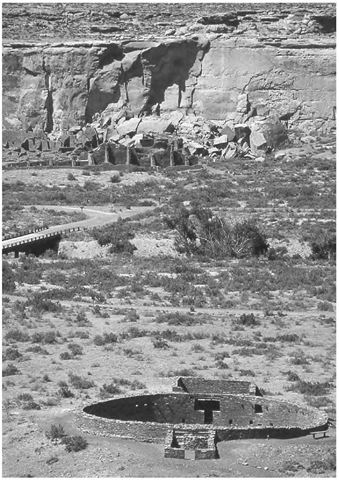Casa Rinconada was the largest of the great kivas in Chaco Canyon. Kivas were subterranean circular buildings used as meeting places or for sacred ceremonies. In Chaco they were generally built with their roofs at ground level, within the central plazas of Great Houses such as Pueblo Bonito, where over thirty-five examples, great and small, are to be found. Casa Rin-conada was unlike the other kivas in both these respects. It was built on its own, separately from any Great House, and while the dirt floor was 3.5 meters (twelve feet) below the surrounding ground level, its walls protruded above the ground. It measured twenty meters (sixty-six feet) across, and its vast roof (of which no trace remains) was supported by four vertical timber uprights placed near the center. There were entrances to the north and south, and around the outer wall were twenty-eight regularly spaced niches together with six larger, irregularly spaced ones.
During the 1970s, archaeoastronomers were apt to scrutinize ancient monuments anywhere in the world for potential solar and lunar alignments reflecting those that had been so famously proposed a decade earlier at Stonehenge in England; Casa Rinconada was analyzed closely in this regard. However, as these early investigators had to admit, the roof was a problem. Only through what seems to have been a single window in the north-northeast could sunlight (or moonlight) actually have entered the kiva, and the best they could come up with was that after sunrise at the summer solstice, a beam of sunlight entering through this window could have illuminated one of six niches that, for some unfathomable reason, were built slightly larger than the rest. However, the window in question has been reconstructed and its original position is uncertain, and even if it is in the original position, it seems that one of the four roof supports may have been in the way. All of this serves to illustrate the dangers of naive “alignment hunting.”
Casa Rinconada and its situation in Chaco Canyon, looking toward Pueblo Bonito on the other side of the valley
It also obscures a more fundamental property of the orientation of Casa Rinconada. The kiva was cardinally aligned: its main axis (through the entrances) was due north-south, and it was also broadly symmetrical about the east-west axis. The intention, surely, was cosmological. Creation myths that have come down to modern indigenous peoples in the vicinity tell how the first kiva was circular to reflect the circle of the sky, and conceptual principles that result in a quartering of space in relation to the cardinal directions are commonplace among indigenous North American groups to this day. As archaeoastronomer Ray Williamson concluded back in 1982, Casa Rin-conada “was meant to serve as an earthly image of the celestial realm; … it was not an observatory, but a ritual building whose structure reflects the central place astronomy had in ancient Pueblo religious practice” (Aveni 1982, p. 205).
It is even more intriguing that principles of cardinality seem to have extended into the landscape. In 1978, archaeologist John Fritz drew attention to the fact that three major Chaco structures, the Great House of Pueblo Alto to the north of the canyon, Casa Rinconada within it, and Tsin Kletzin, another Great House on the mesa to the south, lie on a north-south line. This, argued Fritz, was the main axis of the city. The two largest Chacoan buildings, Chetro Ketl and Pueblo Bonito, lie on either side of this axis, almost equidistant from it, and on an east-west line. Fritz’s contention was that these two cardinal axes were of fundamental importance in the minds of the Cha-coans, a theory that received a dramatic endorsement with the subsequent discovery of what has become known as the (Great) North Road, which extends the north-south axis physically northwards for at least fifty-five kilometers. Archaeologist Steve Lekson has extended this idea still further, arguing the existence of a “Chaco Meridian” that extended from Aztec, over eighty kilometers (fifty miles) north of Chaco, right down to Paquime in modern Mexico, a staggering 630 kilometers (390 miles) to the south.
An investigation in the 1980s of the orientations of the principal walls of Chacoan Great Houses showed that only four out of fourteen of them were aligned cardinally. However, three of the four lie on Fritz’s axes: Pueblo Bonito (north-south) and Pueblo Alto and Tsin Kletzin (both east-west). Casa Rinconada itself was also cardinally aligned, as we have already seen. Only Chetro Ketl stands out as an exception, its principal wall oriented at an azimuth of about seventy degrees. The fact that all but one of the buildings situated on the cardinal axes were themselves cardinally aligned surely adds strength to the idea that the cardinal directions and Fritz’s axes were of fundamental importance. (Conversely, all but one of the buildings not lying on these axes were not cardinally aligned.)
During its first half-century of existence, archaeoastronomy has matured considerably as a discipline, moving on from “alignment hunting” to addressing culturally relevant questions. In the same period, Casa Rin-conada has been transformed from a building containing numerous potential solar and lunar alignments (an idea that never really resonated with the cultural evidence) to a central point within an astronomically referenced sacred landscape.

